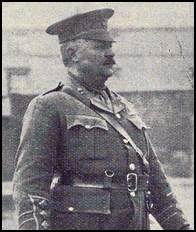
Figure 1. Captain Robert Benfield, R.E.
(Image from The Sapper, February 1943)
Captain
ROBERT
BENFIELD
Royal
Engineers
(formerly 21877 Regimental Sergeant Major)
by
Lieutenant Colonel Edward De
Santis, MSCE, PE, MinstRE
(April 2023)

Figure
1. Captain Robert Benfield, R.E.
(Image from The Sapper,
February 1943)
1. INTRODUCTION
The principal references used in the preparation of this narrative were from a number of sources. They include military service papers from the burnt records files, census records, a family tree from Ancestry.com, and The London Gazette. All sources are contained in the REFERENCE section at the end of the narrative and are cited throughout in the ENDNOTES. Every effort has been made to accurately portray the life and military service of Captain Benfield. Where no citations are provided regarding details of his service, the reader should assume that the information came from his service papers.
Family Information
Robert Benfield was the son of Robert Benfield (1842-1917) and Susan Flew Benfield (1842-1920), née Anthony, both of Portland, Dorsetshire. In addition to Robert, the Benfields had other children: Maria Comben Benfield (1866-1894), Francis Anthony Benfield (1871-1957), Susan Flew Benfield (1877-1944) and Minnie Benfield (1883-?).[1]
Early Life
Robert was born in Portland, Dorset on 25 August 1868 and was baptized on 4 October 1868.[2] In 1871 the Census of England shows 2-year old Robert living with his parents and one sister at 25 Straits in Portland.
1871 Census of England
Census Place: 25 Straits, Portland, Dorset |
|||||
Name and Surname of each Person |
Relation |
Marital Status |
Age |
Profession or Occupation |
Birthplace |
Robert Benfield |
Head |
Married |
28 |
Quarryman |
Portland, |
Susan Flew Benfield |
Wife |
Married |
29 |
|
Portland, |
Maria C. Benfield |
Daughter |
|
4 |
|
Portland, |
Robert Benfield |
Son |
|
2 |
|
Portland, |
Ann Peters |
Servant |
Single |
21 |
Nurse |
Portland, |
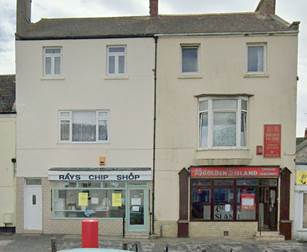
Figure
2. Structures Now in the Vicinity of 25 Straits.
(Image
courtesy of Google Earth)
The Isle of Portland was a quarrying community with a comprehensive range of iconic stone beds. Portland stone is a limestone geological formation (formally named the Portland Stone Formation) dating to the Tithonian age of the Late Jurassic that was (and still is) quarried on the Isle of Portland. The quarries are cut in beds of white-grey limestone separated by chert beds.
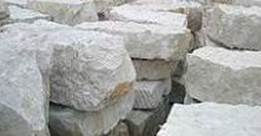
Figure
3. The White-Grey Limestone of Portland.
(Image courtesy of
the British Geological Society)
Portland stone is an oolitic limestone[3] that was deposited around 145-163.5 million years ago during the late Jurassic period, when the UK was situated in a more sub-tropical latitude. Although this Jurassic-aged rock started life as a seafloor sediment, it now adorns the buildings that house powerful people in modern British society.
As noted in the 1871 Census, the elder Robert Benfield worked in one or more of the many quarries to be found on the Isle of Portland. Many other members of the Benfield family, including his son Robert also became quarrymen, as working in the limestone quarries was one of the major sources of employment for men living in the area. In fact, the census shows that almost all the adult males in the adjacent homes to the Benfields were quarrymen.
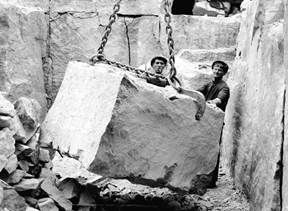
Figure 4.
Quarrymen Moving a Large Limestone Block.
(Image
courtesy of the British Geological Society)
By 1881 the Benfield family had moved to a new residence at 6 New Street in Portland. Robert was then a 12-year old student living with his parents and a brother and two sisters.
1881 Census of England
Census Place: 6 New Street, Portland, Dorset |
|||||
Name and Surname of each Person |
Relation |
Marital Status |
Age |
Profession or Occupation |
Birthplace |
Robert Benfield |
Head |
Married |
38 |
Quarryman |
Portland, |
Susan F. Benfield |
Wife |
Married |
39 |
|
Portland, |
Maria C. Benfield |
Daughter |
|
14 |
Scholar |
Portland, |
Robert Benfield |
Son |
|
12 |
Scholar |
Portland, |
Francis A. Benfield |
Son |
|
10 |
Scholar |
Portland, |
Susan F. Benfield |
Daughter |
|
4 |
|
Portland, |
By 1891 Robert Benfield had already joined the Army and his family had move to 8 New Street in Portland. His father was still working as a Quarryman, as was his 20-year old brother Francis. Another girl, Minnie had been added to the family and 24-year old Maria had married and was now Maria Pearce. In 1891 Maria was still living with her parents. Maria had married one William Pearce (1866-1937), a Sergeant-Instructor in the Royal Engineers. Sergeant Pearce was away on duty at Portsmouth when the 1891 Census was taken.[4]
3. ENLISTMENT
Enlistment
Robert Benfield was recruited for enlistment by a Sergeant Hilyer of the Dorset Regiment at Dorchester on 13 April 1887. At the time of his Attestation Robert declared that his age was 18 years and 7 months and that he was a Stone Cutter. He was not and had never been an Apprentice and he was not married. He also declared that he had never been sentenced or imprisoned by civil Power, that he was not a member of Her Majesty’s forces, that he had no prior naval or military service and that he had never been rejected as unfit for military service. Robert stated that he was willing to be vaccinated and that he wanted to enlist in the Royal Engineers. As a stone cutter (or quarryman) in civil life his experience was well suited for one of the trades needed by the Royal Engineers when on active service, so his preference for that Corps made it almost a certainty that he would become a Sapper.
Benfield was given a medical examination on the date of his enlistment and he was found fit to serve. His Certificate of Primary Military Examination was issued at Dorchester on the date of his Attestation by a Captain in the 39th Regimental District[5] indicating that he was fit for service in the Army. His Attestation was certified by the Colonel Commanding the 39th Regimental District and he was declared fit for service in the Corps of Royal Engineers, Regimental Number 21877.
4. DESCRIPTION ON ENLISTMENT
The following is a description of Robert Benfield at the time that he enlisted in the Army on 13 April 1887.
Height: |
Not legible in his service papers due to burnt pages. |
Weight: |
121 pounds (*) |
Chest measurement: |
34 inches |
Complexion: |
dark |
Eyes: |
hazel |
Hair: |
brown |
Distinctive marks: |
Indistinct face and seven dots tattooed on back of left forearm. Wart on left buttock. |
Religion: |
Wesleyan |
NOTE: (*) The photograph of Benfield in Figure 1 indicates that he weighed far more than 121 pounds by the time that he became a Captain in 1915.
5. POSTINGS AND CAMPAIGN SERVICE
Training
Following the administrative actions involved with his enlistment, Benfield was sent off for his recruit training. With the exception of Drivers, every recruit enlisted for the Royal Engineers had to have a trade. Pioneers and Sappers were sent to Chatham where they were trained for a year in infantry drill and pioneer duties. During the summer every training company in turn went into a tent-camp at Wouldham near Chatham, where the recruits were taught camp duties, pontooning and other field engineering tasks. The engineer recruits also received musketry training. When the course of training was completed the recruits had to pass an examination and were then transferred to engineer formations, where they received higher pay and could earn extra allowances by working at their special trades.
While undergoing his recruit training in the Training Battalion at Chatham, Benfield was promoted to the rank of Lance Corporal. He also was awarded a Fourth Class Certificate of Education and a Third Class Certificate of Education while at Chatham. The Fourth Class Certificate was abolished in 1888, so he was one of the last men to ever receive it.[6]
Aldershot (1888-1891)
After completing his recruit training at Chatham, Lance Corporal Benfield was posted to the 23rd Field Company with the 1st Division at Aldershot, Hampshire. This company, along with two other field companies, would provide general field engineering support to units of the division.
On 1 April 1889 he was promoted to 2nd Corporal and during that same year he was awarded the Second Class Certificate of Education. On 1 February 1891 he was promoted to the rank of Corporal. It appears that at some point during 1891 he was posted to Chatham.
Chatham (1891-1894)
Corporal Benfield was posted to the Training Battalion at Chatham in 1891. On 22 December 1891 Benfield married Emily Bishop (1869-1945) at Medway, Kent, without leave; that is, without the permission of his commanding officer. Only 4 percent of Corporals in the engineers were normally granted leave to marry, and then with certain conditions.[7]
In 1892 he attended the Musketry Course at Hythe. The school was intended for special training of officers, warrant officers and non-commissioned officers of all branches of the service to qualify them as instructors. Preliminary drills, as laid down for a recruit, occupied 8 days of training followed by an extended course of practice, including field-firing and practice with the revolver. Drill and practice with various weapons was taught. Night firing and judging distance by night was carried out and a final examination was given in (1) firing exercises, (2) judging distance, (3) stadiometer (height measurement), (4) range finders, (5) musketry returns, (6) theoretical principles, and (7) care of arms.[8] His attendance at the course was obviously in preparation for making him an instructor.
On 2 June 1893 he extended his service to complete 12 years with the Colours. On 1 April 1894 he was promoted to Sergeant and posted as a Drill Instructor in the Training Battalion.
Aberdeen (1894-1903)
In October of 1894 Benfield was posted as a Volunteer Instructor in Aberdeen. It is most likely that he was posted to the 1st Aberdeenshire Royal Engineers (Volunteers). The formation of the 1st Aberdeenshire Engineer Volunteers, a corps with an establishment of one company, was sanctioned on 22 April 1878, and the first officers were gazetted on 29 June. For purposes of the capitation grant, the corps was attached to the 1st Lanarkshire Engineer Volunteers. On 2 March 1880 the corps was increased to two, and in 1883 to four companies. In 1884 it was constituted as an independent unit, no longer attached to the 1st Lanark, and in 1888 it was increased to six companies, all of them in the city of Aberdeen. In the latter year its title was changed to "1st Aberdeenshire Engineer Volunteers, Fortress and Railway Forces, Royal Engineers " and this nomenclature remained in force till 1901.
Benfield’s assignment to this volunteer unit would have been as a Permanent Staff member of the Regular Army posted to instruct the Non-Commissioned officers and Other Ranks of the unit in drill and field engineering work. In fact, in 1895 Benfield appears to have been posted to Chatham temporarily to complete the Field Works course so that he could more effectively train the volunteer unit.
On 21 April 1896, while in Aberdeen, Benfield re-engaged to complete 21 years of service with the Colours. His decision to make the Army his career had obviously been made.
On 31 March 1901 the Census of Scotland was taken in Aberdeen. The Benfield family was then composed as shown in the table below.
1901 Census of Scotland
Census place: 269 Union Grove, Aberdeen, Scotland |
||||
Name and Surname of each Person |
Relation |
Marital Status |
Age |
Profession or Occupation |
Robert Benfield |
Head |
Married |
32 |
Sergeant Instructor |
Emily Benfield |
Wife |
Married |
32
|
|
Leticia E. Benfield |
Daughter |
|
8
|
|
Elsie Maria Benfield |
Daughter |
|
6
|
|
Margaret Ross |
Servant |
|
37
|
Nurse |
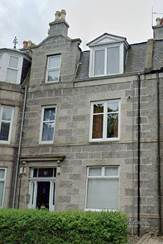
Figure
5. The Benfield Home at 269 Union Grove, Aberdeen.
(Image
courtesy of Google Earth)
On 1 January 1903 Sergeant Benfield was promoted to the rank of Company Sergeant Major and on 13 January he was finally placed on the married roll. On 1 October 1903 he was awarded the First Class Certificate of Education. First-class certificates were a great deal more difficult to obtain and were required for commissions from the ranks. Successful candidates had to read and take dictation from any standard author; make a fair copy of a manuscript; demonstrate their familiarity with more complicated mathematics, except cube and square root and stocks and discount; and as well prepare for examination in at least one of a number of additional subjects. After 1887 candidates were examined in British history and geography in place of a special subject. First-class Certificates were awarded on the results of periodic examinations held by the Council (later Director-General) of Military Education.[9] His efforts at improving his education were surely part of his plan to receive a commission at some point in the future.
Chatham (1903-1908)
Prior to the end of 1903 Company Sergeant Major Benfield was posted to the School of Military Engineering (S.M.E.) at Chatham and on 30 December of that year he was appointed Quartermaster Sergeant Instructor and the Senior Drill Instructor in the Training Battalion. The Training Battalion was commanded by Brevet Colonel A.G. Thomson, R.E. Benfield was posted to the battalion’s “A” Company, commanded by Captain B.H.O. Armstrong, with Lieutenant Frank Bertram Legh[10] as the company’s second in command.[11]
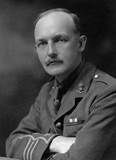
Figure
6. Lieutenant Frank Bertram Legh, R.E.
(Image from the
author’s collection)
Benfield was granted Service Pay Class I while filling the position of Senior Drill Instructor. Service Pay in addition to their regular pay, was granted to men in the Royal Engineers who demonstrated proficiency in their military trades. Service Pay was awarded in seven classes, with Class I being the highest.
By Army Order 189 of 1905, Company Sergeant Major Benfield was awarded the Army Long Service and Good Conduct Medal (EVIIR). On 29 November 1905 he was awarded Trade and Special Qualifications as a Senior Drill Instructor, certified by Lieutenant Frank Bertram Legh, R.E.
On 3 May 1907 Benfield was promoted to Sergeant Major in the S.M.E. and he remained in the Training Battalion as the Regimental Sergeant Major. On 5 February 1908 he was permitted to continue in service for a further period until 2 April 1912 to complete 5 years in the Warrant Officer rank. During this period he was serving in “A” Company of the Training Battalion for administrative purposes.
Hong Kong (1908-1910)
Benfield’s first posting abroad was to Hong Kong to join the 40th Fortress Company. He departed the U.K. on 26 September 1908, presumably with his family. As he was a Sergeant Major at the time, it is safe to assume that he joined the company as the Company Sergeant Major.
The 40th Fortress Company was stationed at Victoria Barracks in Hong Kong, which also was the location of the R.E. Headquarters there. The Chief Engineer in Hong Kong at the time of Benfield’s arrival was Colonel Charles Henry Darling, R.E. and the Officer Commanding the 40th Company was Captain B.S. Phillpotts.[12]
The role of a fortress company was to assist in the defence of ports and harbours that had significant military importance. This was accomplished by the use of mines and searchlights and by supporting the Royal Artillery garrison co-located with the fortress company. A Royal Engineers fortress company typically would provide the following services in defence of ports and harbours:
Construction and maintenance of fortifications and gun emplacements.
Construction of ammunition storage areas and magazines.
Construction and maintenance of roadways.
Water supply to units manning the fortifications.
Supply of electricity to installations within the fortress area.
Provide searchlight support to anti-shipping artillery batteries.
Provide engineer works in and around the harbour and port areas.
Benfield remained with the company until 26 October 1910. At the time of his departure from Hong Kong the Commander Royal Engineers (C.R.E.) of the district was Lieutenant Colonel Geoffrey D. Close, R.E. and the O.C. of the 40th Fortress Company was Major St. G.R.S. Caulfield, R.E.[13]
Upon his return to England on 30 November 1910 he was posted to “A” Company of the Royal Engineers Depot at Chatham under the command of Colonel John Edward Capper,[14] CB, R.E.[15] He appears in the 1911 Census of England (dated 2 April 1911) in the Royal Engineers Barracks, Brompton, Chatham as a married, 42-year old Sergeant Major. His family also appears in the 1911 Census taken in Gillingham, Kent, a town adjacent to Chatham and Brompton Barracks where Benfield was serving. This census lists the composition of the Benfield family as shown in the table below.
1911 Census of England
Census Place: Gillingham, Kent |
|||||
Name and Surname of each Person |
Relation |
Marital Status |
Age |
Profession or Occupation |
Birthplace |
Emily Benfield |
Wife |
Married |
42 |
|
Old Brompton |
Letitia Emily Benfield |
Daughter |
Single |
18 |
Dressmaker |
New Brompton |
Elsie Maria Benfield |
Daughter |
Single |
16 |
Milliner |
New Brompton |
Winifred Annie Benfield |
Daughter |
|
10 |
School |
Aberdeen |
Edna Benfield |
Daughter |
|
4 |
|
New Brompton |
NOTE: No specific home address is given for the family other than Gillingham, Kent.
In September 1911 Sergeant Major Benfield was awarded the George V Coronation Medal and in 1912 he was permitted to continue in service for a further period until he attained the age of 45 years.
On 12 September 1913, while serving in “A” Company of the R.E. Depot , Sergeant Major Benfield was discharged from the Army.[16] He was admitted to the Royal Hospital Chelsea for a discharge medical examination and was discharged from hospital on 26 September.[17] At this point he was ready to settle down to civil life with his family, but this was not to happen. In a little over a year from the date of his discharge he would be recalled to duty.
5. COMMISSIONED SERVICE
Benfield was recalled to the Royal Engineers on 31 October 1914 for service in the Great War of 1914-1918. Upon recall he was appointed a Quartermaster with the honorary rank of Lieutenant and was posted to the Royal Engineers Signal Section at Aldershot.[18] He was promoted to the rank of Temporary Captain on 22 June 1915 and was posted to the Royal Engineers Signal Service as Adjutant in the Bedford, Birmingham and Maresfield areas. At this time “G” Company, “A” Signal Depot, Royal Engineers was stationed at Bedford. It is most likely that he became the Adjutant of the Signal Depot there, with duties that took him to R.E. Signals units in Birmingham and Maresfield. Other Signals units in the areas of his responsibility included:[19]
· The East Anglian Divisional Telegraph Company in Bedford,
· The Southern Command Cable Telegraph Company in Birmingham,
· The Southern Airline Telegraph Company in Birmingham,
· The 53rd Divisional Signal Company in Bedford,
· The 48th (City of Birmingham) Signal Squadron (Volunteers) in Birmingham,
· A company of the Southern Command of the Territorial Force located in Birmingham, and
· A Signal Training Centre and School of Signals at Maresfield.
NOTE: The East Anglian Divisional Telegraph Company was headquartered at Ashburnham Road in Bedford under the command of Captain H.J. Randall, R.E. The Southern Command units were located at The Barracks on Great Brook Street in Birmingham.[20]
Benfield’s service papers do not indicate how he obtained the qualifications to serve as the Adjutant of a unit in the Royal Engineers Signal Service. His records do not show any formal training in this field. Perhaps his duties were purely administrative or perhaps his Drill Instructor skills were used to improve the military skills of the men in these units.
Captain Benfield served in the capacity until 1920 when he retired from the Army.[21] He was awarded a pension of 48 pence per day[22] for life and he chose to live with his family at 93 Malvern Road in Gillingham, Kent.
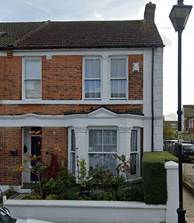
Figure
7. The Benfield Home at 93 Malvern Road in Gillingham.[23]
(Image
courtesy of Google Earth)
__________________________________________________________________________
The following sections are presented in tabular form to summarize Benfield’s promotions, appointments, military training and qualifications and the medals that he was awarded during his time in the Army. They are provided to give the reader easy access to these aspects of his military career. The tables are followed by sections dealing with his marriage, family, personal information and post-service life.
__________________________________________________________________________
6. PROMOTIONS AND APPOINTMENTS
Promotions: Benfield received the following promotions during his time in service:
Date of Promotion or Appointment |
|
13 April 1887 |
Sapper, upon enlistment in the Royal Engineers |
About September 1887 |
Promoted Lance Corporal |
1 April 1889 |
Promoted 2nd Corporal |
1 February 1891 |
Promoted Corporal |
1 April 1894 |
Promoted Sergeant |
1 January 1903 |
Promoted Company Sergeant Major (Warrant Officer Class II) |
30 December 1903 |
Appointed Quartermaster Sergeant Instructor (Warrant Officer Class II |
3 May 1907 |
Promoted Sergeant Major (Warrant Officer Class I) |
31 October 1914 |
Appointed Temporary Lieutenant |
22 June 1915 |
Promoted Temporary Captain |
Appointments: Benfield received the following appointments during his time in service:
Date of Appointment |
|
1 April 1894 |
Appointed Drill Instructor |
October 1894 |
Appointed Volunteer Instructor |
31 March 1901 |
Appointed Sergeant Instructor |
30 December 1903 |
Appointed Quartermaster Sergeant Instructor |
29 November 1905 |
Appointed Senior Drill Instructor |
3 May 1907 |
Appointed Regimental Sergeant Major (R.E. Training Battalion) |
26 September 1908 |
Appointed Company Sergeant Major (40th Fortress Company) |
22 June 1915 |
Appointed Adjutant, R.E. Signal Service |
7. MILITARY TRAINING, EDUCATION AND QUALIFICATIONS
Military Training: Benfield was given the following military training while he served in the ranks:
Date |
Training |
13 April 1887 |
Recruit training following enlistment at the School of Military Engineering, Chatham |
1892 |
Musketry training at the School of Musketry, Hythe |
1895 |
Field Works Course at the School of Military Engineering, Chatham |
Military Education: Benfield received the following education while serving in the ranks:
Year |
Education |
1887 |
Awarded a Fourth Class Certificate of Education |
1887 |
Awarded a Third Class Certificate of Education |
1889 |
Awarded a Second Class Certificate of Education |
1903 |
Awarded a First Class Certificate of Education |
Qualifications: Benfield received the following classifications while serving in the Army:
Date |
Qualification |
1 April 1894 |
Drill Instructor |
October 1894 |
Permanent Staff as a Volunteer Instructor |
30 Dec 1903 |
Senior Drill Instructor |
3 May 1907 |
Engineer Training Battalion Sergeant Major |
26 Sep 1908 |
Fortress Company Sergeant Major |
22 June 1915 |
Adjutant, Royal Engineers Signal Service |
8. MEDALS, AWARDS AND DECORATIONS
While serving in the ranks Benfield was awarded the Army Long Service and Good Conduct Medal in 1905 and the King George V Coronation Medal in 1911.
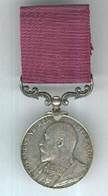
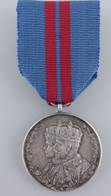
Figure 8 and 9. The Army Long
Service and Good Conduct Medal (EVIIR)
and the George V
Coronation Medal.[24]
(Images
courtesy of Wikipedia)
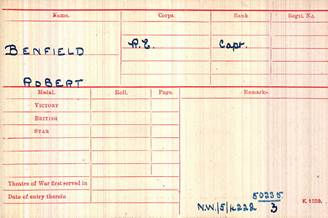
Figure
10. The Great War Medal Index Card of Captain Robert Benfield,
R.E.
(Image courtesy of Ancestry.com)
Although Benfield served at home in the Army during the Great War of 1914-1918, his Medal Index Card for that war shows no awards of any medals for that service. The most common medals awarded for service during the Great War were the British War Medal and Victory Medal. To receive the British War Medal, officers and men were required to have either entered an active theatre of war or to have left the United Kingdom for service overseas between 5 August 1914 and 11 November 1918, and to have completed 28 days mobilised service.[25] Benfield did not meet this criterion. To receive the Victory Medal, officers and men needed to have served in the armed forces of the United Kingdom or the British Empire, or with certain recognized voluntary organizations, and have entered any theatre of war between 5 August 1914 and 11 November 1918.[26] Benfield did not meet these criteria; hence, there were no medals to be had for him for his war service.
9. RELEASE FROM SERVICE
Captain Benfield was released from service in 1920 following the end of the Great War. His total service was reckoned as shown in the tables below:
Location |
|
Chatham |
13 April 1887 - 1888 |
Aldershot |
1888 - 1891 |
Chatham |
1891 – October 1894 |
Aberdeen |
October 1894 - 1903 |
Chatham |
1903 – 26 September 1908 |
Hong Kong |
26 September 1908 – 30 November 1910 |
Chatham |
30 November 1910– 12 September 1913 |
Bedford, Birmingham and Maresfield |
31 October 1914 - 1920 |
Location |
|
Home Service (In the Ranks) |
26 years and 5 months |
Home Service (Commissioned) |
5 years, 11 months and 16 days |
Service Abroad |
2 years, 2 months and 5 days |
Total Service |
32 years, 4 months and 16 days |
TABLE NOTE: The periods of service are approximated because precise dates are not known in many cases.
The numerous postings to Chatham shown in his record were due to the fact that he had been appointed a Drill Instructor early in his career and had remained an instructor during most of his time in the Army. Since the School of Military Engineering was located at Chatham, it was not unusual for him to receive many postings there.
10. POST SERVICE LIFE
As mentioned earlier, the Benfield family resided in Gillingham, Kent immediately following Captain Benfield’s release from service in 1920. He was 52 years old when he left the Army with his pension. No information was uncovered regarding any employment after leaving the Army.
The 1939 Register shows Benfield and his wife living at 46 Victoria Avenue in Saffron Walden, Essex. He was 68 years of age and his occupation in the register is shown as Captain, Royal Engineers (Retired). Another couple was living at the same address. They were Mr. Arthur Newman, a 69-year old retired Fitter, and his wife Alice, 71.
Robert Benfield died at St. Bartholomew’s Hospital in Rochester, Kent on 11 December 1942 at the age of 74, after as short illness. Apparently his association with the Royal Engineers and his association with the Medway area of Kent may have caused him and Emily to return to Kent from Essex. He was buried in Woodlands Cemetery in Gillingham, Medway Unitary Authority, Kent the day after his death. Probate of his will took place in Llandudno, Wales on 15 March 1943. His heir was his wife Emily and his effects amounted to £2,483 and 4 shillings (about $185,525 US in 2023 currency).
Emily Benfield died at 42 Magpie Hall Road in Chatham on 1 January 1945. She was buried in Woodlands Cemetery in Gillingham, probably with her husband. Probate of her will took place in Llandudno, Wales on 25 June 1946 with her effects going to Letitia Emily Dales, widow, and Elsie Maria Bullen (wife of Elliott Thomas Bullen). Emily’s effects amounted to £3,551, 12 shillings and 9 pence, or about $240,750 US in 2023 currency. The rather substantial amount of money left to Emily by Robert’s death, and the additional amount accumulated by her after his death, surely indicates that Robert was employed for some time following his release from the Army and Emily either worked or invested her money wisely.
11. MARRIAGE, FAMILY AND PERSONAL INFORMATION
Spouse and Children[27]
Robert Benfield’s wife, the former Emily Bishop (1869-1945), was born on 25 March 1869 in Old Brompton, Kent. In addition to Benfield’s many postings to Chatham, it is no wonder that the family had an affinity for the area, as it was Emily’s childhood home.
Emily married Robert in Medway, Kent in October 1891. Robert and Emily had four daughters:
Letitia Emily Benfield (1892 – 1982) was born in Medway, Kent on 13 December 1892 while her father was serving at the School of Military Engineering at Chatham. Letitia married Reginald Francis Dales (1895-1938) in January 1920 at Birkenhead, Cheshire and they had one daughter, Frances Lititia Dales (1921-2012). Although Reginald Dales would have been of age to serve in the Great War, no record could be found that he did serve.
Letitia died in Exeter, Devonshire in July 1982 at the age of 89. Her husband had predeceased her in Birkenhead in October 1938 at the age of 43.
Elsie Maria Benfield (1894-1985) was born in New Brompton, Kent on 7 July 1894 while her father was serving as a Drill Instructor in the Royal Engineers Training Battalion at Chatham. Elsie married Elliott Thomas Patrick Edward Bullen (1892-1962) in January 1918 in Bedford, Bedfordshire. Elsie and Elliott did not have any children.
Elliott served in the Royal Engineers, 16277 Corporal (Acting Sergeant) during the Great War and was Mentioned in Despatches on 18 May 1917. Elliott had two Medal Index Cards for his service in the Great War, one named to him as E.T.P. Bullen and the other as Elliott T.P. Bullen. The first card provides the most detailed information. It shows him as 16277 Temporary Sergeant, Royal Engineers arriving in France on 22 August 1915. The back of this card also shows that the Officer Commanding No. 1 Group Depot Company, R.E. requesting his Mention in Despatches oak leaf emblem on 26 January 1920. Both cards indicate the he was awarded the 1914-15 Star, British War Medal and Victory Medal. The front side of his Medal Index Card is shown below.
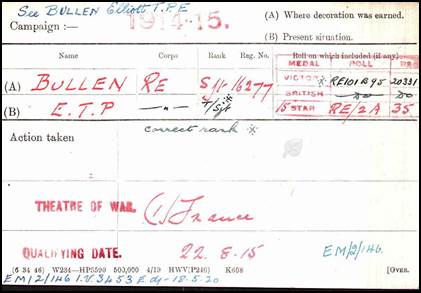
Figure
11. The Medal Index Card of E.T.P.(E) Bullen, R.E.
(Image
courtesy of Ancestry.com)
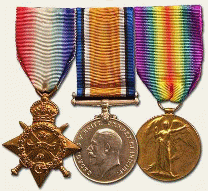
Figure
12. Examples of the Medals Awarded to Elliott T.P.E. Bullen,
R.E.[28]
(Image
from the author’s collection)
Elliott Thomas Patrick Edward Bullen died in Southbourne, Bournemouth, Hampshire on 18 July 1962. Elsie Maria Benfield died in Sindlesham, Wokingham, Berkshire on 25 October 1985 at the age of 91.
Winifred Annie Benfield was born in Aberdeen, Aberdeenshire, Scotland on 29 March 1901 while her father was serving as a Volunteer Instructor there. She married George Arthur Knight (1898-1975) in Medway, Kent in July 1926. Winifred and George did not have any children. A George Arthur Knight served in the Royal West Surrey Regiment during the Great War; however, Medal Index Cards exist for 18 other men named George A. Knight who served in the war, so it is not possible to know with certainty if Winifred’s husband was one of them. George died in Gillingham, Kent on 1 December 1975. Winifred died in Tutshill, Chepstow, Gwent, Wales on 17 April 1984 at the age of 83.
Edna Benfield was born in New Brompton, Kent in April 1907 while her father was serving in the Royal Engineers Training Battalion at Chatham. Edna married Ronald B. Newman in Medway, Kent in July 1930. Edna and Ronald did not have any children.
Information regarding Ronald B. Newman’s date of birth could not be found, but if he was considerably older than Edna, he could have seen service in the Great War. Two Medal Index Cards were found, one for a Ronald B. Newman and one for an R.B. Newman; however, both cards were for the same man. The MIC for Ronald B. Newman shows him as GS/87283 Private in the Royal Fusiliers with a transfer to the Royal Engineers Signal Service as 613781 Corporal and then to the Royal Corps of Signals as 2308519 Corporal. The card indicates that he was entitled to the British War Medal and Victory Medal for service during the war and was also issued a Silver War Badge, perhaps due to illness. The Silver War Badge list for the Royal Fusiliers indicates that Newman enlisted on 20 February 1917 and was discharged on 30 January 1919. In 1923 he was serving in Baghdad when he put in a claim for a replacement British War Medal. Apparently he had recovered from whatever caused his discharge in 1919 and he subsequently re-enlisted.
The second MIC for R.B. Newman shows him as 2308519 Regimental Sergeant Major, Royal Signals. This card indicates that he was in possession of an Army Long Service and Good Conduct Medal as well as the British War Medal and Victory Medal. The card also shows that he was posted from the Middle East to India on 8 July 1941 and was serving with Headquarters of the 3rd Line of Communication, Z Force. This is a very unusual card as it was prepared during the period of World War 2.
It must be realized that it is pure speculation that the man identified on the two Medal Index Cards was the husband of Edna Benfield. No detailed information about Ronald B. Newman could be found in any family tree in Ancestry.com. The information in Edna’s page in the Benfield family tree also is sparse, showing only her date of marriage to Newman, but no date of his death. Even the date of Edna’s death is not known.
Parents
Robert Benfield (1842-1917) was born in October 1842 in Portland, Dorsetshire. His parents were Robert Benfield (1813-1875) and Maria Benfield, née Comben (1813-1885). Robert had five brothers and the family was well established in Portland with most of the men working in the quarries located there. Robert married Susan Flew Anthony in Portland on 12 November 1865. He died at 19 New Street in Portland on 14 May 1917 at the age of 74 and was buried in St. Georges Churchyard in Portland on 16 May 1917.
Susan Flew Benfield, née Anthony (1842-1920) was born in April 1842 in Portland, Dorset. Her parents were Robert White Anthony (1816-1873) and Frances Rebecca Anthony, née Flew (1818-1901). Susan only had one sibling, a sister. Like the Benfield’s, the Anthony family was a well established family in the town of Portland. Susan died in Portland on 30 July 1921 at the age of 78 and buried on 2 August 1920 with her husband.
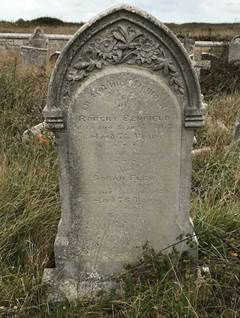
Figure
13. The Gravestone of Robert and Susan Benfield
in St. Georges
Churchyard, Portland, Dorset.
(Image courtesy of the
Morgan/Hampson family tree)
Siblings
Maria Comben Benfield (1866-1894) was born in Portland, Dorset in October 1866. She married William Pearce (1866-1937) in the Easton Wesleyan Chapel in Portland on 23 January 1890. Maria and William did not have any children. She died in April 1894 on Portsea Island, Hampshire at the age of 27. Since Maria died at such an early age one may consider that she may have died in childbirth. William died at Portsmouth, Hampshire on 6 January 1937.
Francis Anthony Benfield (1871-1957) was born in Portland, Dorset on 30 March 1871. He married Sarah Sansom (1874-1966) in Portland on 3 February 1895. Francis and Sarah had three sons and four daughters. Francis died on the Isle of Wight, Hampshire on 6 March 1957. Sarah died on the Isle of Wight on 14 January 1966.
Susan Flew Benfield (1877-1944) was born in Portland in January 1877. She married William Joseph Cuerel (1862-1926) at Portland in October 1898. Susan and William had two sons and a daughter. Susan died on 6 November 1944 at 37 New Street in Portland. William predeceased his wife at the same address on 30 November 1926.
Minnie Benfield (1883-?) was born in Portland, Dorset on 11 January 1883. She married David Christopher Williams (1880-1950) in Portland in July 1906. Minnie and David had a son and a daughter. David died in Portland on 8 May 1950. The date of Minnie’s death is unknown.
REFERENCES:
Army Lists
1. Hart’s Annual Army List, 1915, pp. 301 and 306.
2. Quarterly Army List, October 1916, p. 2142.
3. Monthly Army List, June 1919, p. 802g.
Books
1.
FARWELL, B. Mr.
Kipling’s Army All the Queen’s Men.
W.W. Norton & Company, New York, 1981, p.228.
2. GRIERSON, J.M. Scarlet Into Khaki: The British Army on the Eve of the Boer War. Greenhill Books, London, 1988, p. 185.
3. SKELLEY, A.R. The Victorian Army At Home: The Recruitment and Terms and Conditions of the British Regular, 1859-1899. McGill-Queen’s University Press, Montreal, 1977, pp. 94, 95, and 311.
Census
1871 Census of England (RG 10/2006).
1881 Census of England (RG 11/2107).
1891 Census of England (RG 12/1650) – Portland, Dorset.
1891 Census of England (RG 12/871- Portsea, Portsmouth.
1901 Census of Scotland (CSSCT1901_58)
1911 Census of England (Brompton Barracks)
1911 Census of England (Gillingham, Kent)
1939 Register.
Civil Documents
Probate Calendar, 1943, p. 353.
Probate Calendar, 1945, p. 427.
Marriage Certificate: George Arthur Knight and Winifred Annie Benfield, 14 July 1926.
Family Trees
Robert Benfield (1842-1917) – father
Susan Flew Benfield, née Anthony (1842-1920) - mother
Robert Benfield (1868-1942) – main character
Emily Benfield, née Bishop (1869-1945) - wife
Letitia Emily Benfield (1892-1982) – daughter
Elsie Maria Benfield (1894-1985) – daughter
Winifred Annie Benfield (1901-1984) – daughter
Edna Benfield (1907-?) - daughter
Internet Web Sites
British Geological Society – images from the collection. (BGS image ID: P023962)
http://britgeoheritage.blogspot.com/2013/03/raising-block-of-portland-stone-from.html
London Gazette
Supplement to the London Gazette, 31 October 1914, p. 8848.
London Gazette, 18 May 1917, p. 4879.
Military Documents
Great War Medal Index Card – Robert Benfield.
Great War Medal Index Card – E.T.P. Bullen.
Great War Medal Index Card – Elliott T.P.E. Bullen
Mention in Despatches Card - E.T.P.E. Bullen.
Great War Medal Index Card of Ronald B. Newman (card number 1).
Great War Medal Index Card of R. B. Newman (card number 2).
Royal Fusiliers Silver War Badge roll – Ronald B. Newman.
Royal Hospital Chelsea Pensioner Admissions and Discharges, 1915-1925.
Service Papers (Burnt Records File)
b. Description on Enlistment.
c. Statement of Service.
d. Trade and Special Qualifications.
e. Military History Sheet.
f. Casualty Report.
Periodicals
1. Army and Navy Calendar for 1882/83 – 1893/94.
The Sapper, February 1943, p. 102.
Royal Engineers Lists
The Royal Engineers List, November 1905, p. xxiii.
The Royal Engineers List, September 1908, p. xxvii
The Royal Engineers List, October 1910, p. xxiv.
The Royal Engineers List, December 1912, p. xxi.
ENDNOTES:
[1] Morgan/Hampson Family Tree.
[2] Ibid.
[3] Oolitic limestone is made up of small spheres called ooiliths that are stuck together by lime mud. They form when calcium carbonate is deposited on the surface of sand grains rolled (by waves) around on a shallow sea floor.
[4] 1891 Census of England (RG 12/871).
[5] The Dorsetshire Regiment.
[6] See Certificates of Education.
[7] FARWELL, B. Corporals would be granted leave to marry on condition of their having served seven years, and that they had two good conduct badges, and proved that they had at least 5 Pounds in the savings bank. At the time of his marriage, Benfield did not meet the 7-year of service condition.
[8] Army and Navy Calendar for 1882/83 – 1893/94.
[9] SKELLEY, A.R.
[10] The medals of Lieutenant Colonel Frank Bertram Legh, O.B.E., M.C., R.E. are in the author’s collection.
[11] The Royal Engineers List, November 1905, p. xxiii.
[12] Ibid. September 1908, p. xxvii.
[13] Ibid. October 1910, p. xxiv.
[14] Later Major General Sir John Edward Capper, K.C.B., K.C.V.O.
[15] Ibid. December 1912, p. xxi.
[16] Quarterly Army List, October 1916, p. 2142. Warrant Officers in Receipt of Pensions.
[17] Pensioner admissions records.
[18] The Sapper, February 1943 and the London Gazette of 21 October 1914.
[19] Hart’s Annual Army List, 1915, pp. 301-306.
[20] Ibid.
[21] He retired prior to December 1920 as his name does not appear in the Army List for this month.
[22] At 240 old Pence per Pound and 365 days per year, his pension amount to £73 per year.
[23] This address was taken from a notation on the back of his Medal Index Card.
[24] NOTE: These are not Benfield’s medals. The whereabouts of his medals is unknown.
[25] Wikipedia.
[26] Ibid.
[27] Information obtained from the family trees on Ancestry.com.
[28] These are not Bullen’s medals. They are included only to show what the medals look like. The whereabouts of his medals is unknown.